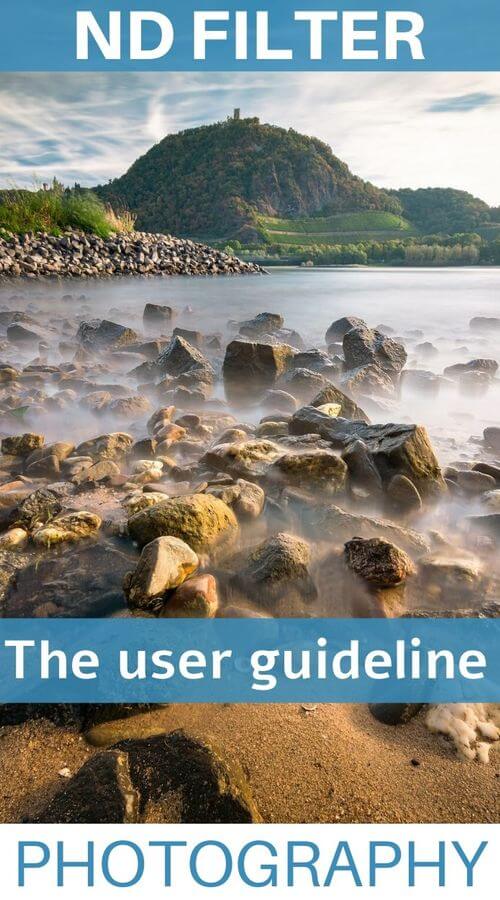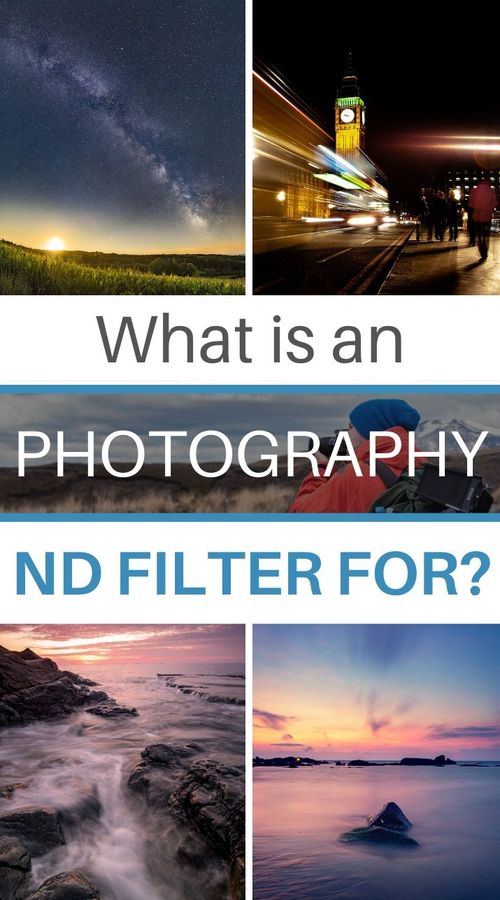What is the purpose of an ND filter in photography?
Last update: 04/19/2024
Our blog continues to grow thanks to you, our readers. This post may contain affiliate links, which means we can earn a small commission if you make a purchase through them, at no extra cost to you. This helps us to continue to bring you more and support our work!
If you are new to photography or have not looked into filters since you bought your camera, you may be wondering how to take pictures of waterfalls or blurred seas. A large majority of photographers taking these types of photos use special filters, called neutral density filter, more commonly known as ND filters. After explaining the usefulness of a polarizing filter in a previous article, I am now going to use this article to explain what an ND filter is used for. We will see how useful it is in photography and how it will help you improve your photos.

This article is the first in a series of articles on ND filters.
As Amazon Associates, we earn from qualifying purchases. It means that, all the links linking to camera gear in this post are redirecting to Amazon stores
What is an ND filter or neutral density filter?
ND filters are filters (!) that are placed in front of the camera lens to obtain particular effects. The advantage of a neutral density filter is that it reduces the amount of light getting through to the sensor of your camera. It has a variable opacity depending on the filter. To put it simply, the ND filter may be more or less black depending on your choice, which determines how useful it is.
The more opaque (black) your ND filter is, the more light it will absorb. So why would anyone want to absorb light, you might be wondering? The idea is not to make the photo darker (that’s not the point of it), the goal is to add certain effects to your photo.

Landscape photography and filters are a great combination. Here is the ND Big Stopper filter from Lee – More details on Amazon
In two other articles I discuss how to choose an ND filter (according to which criteria) and also how to use an ND filter for long exposures, for example.
What is the purpose of an ND filter?
As I’ve just explained, the only reason for using an ND filter is to absorb light. Here I will explain in more detail what an ND filter is used for in photography.
If we don’t adjust the settings of our camera, the picture will be darker when not using an ND filter. We therefore compensate for this loss of light by adjusting one or more of the exposure settings used for taking the photo, namely:
- The shutter speed: we can decrease the speed to let more light in to our sensor (for example, from 1/100th to 1/20th). This is one of the major advantages of the ND filter since it allows us to reduce the shutter speed and at the same time take the picture using long exposures in conditions where it would be difficult without a filter,
- The aperture of the diaphragm: we can “open the diaphragm”, i.e. bring in more light by going from an f/11 to an f/5.6 for example (but beware of the effect that it may have on your photo),

- ISO sensitivity: The ISO can be increased to make the sensor more sensitive to light (e. g. from ISO 100 to ISO 800), but be careful to keep an eye on the noise effect (grain) on your photo.
You’re now thinking, that’s all very well, but what’s the use of an ND filter then? I’m coming to that. As I just explained, one of the main reasons for using an ND filter is to be able to slow down the shutter speed used when taking your photo. So, in which situations would this be useful?
For me there are 3 cases where an ND filter is useful in photography.
1 - To achieve a long exposure shot
So we’ve now come back to what I was saying in the introduction of this article. One of the great advantages of the ND filter is that it can help you achieve long exposures, especially in the middle of the day when the sun is the brightest and harshest. Indeed, in broad daylight, it is impossible to achieve a long exposure even using optimal settings on your camera (ISO at the lowest and closing the diaphragm at the maximum). The shutter speed will always be too fast and therefore the scene will not be in motion.
In addition, an ND filter, as explained above, allows you to absorb light and thus increase the exposure time.

Long exposure times are particularly used to achieve superb effects on large expanses of water (sea, rivers, streams, fountains), but also on clouds, stars or even lines of traffic. Your choice of ND filter will very much depend on your shooting habits (shooting during the day, the evening, at night) and according to the effects you want to achieve (fog effect on the sea, complete smoothing of the image, etc.).
However, in order to use this technique you will need a tripod to hold your camera as exposure times can range from 10 seconds to several minutes!
2 - To maintain a shallow depth of field
If you want to know what an ND filter is used for, besides long exposures, this is another positive reason. These filters are particularly useful for maintaining a shallow depth of field, especially (but not only!) for portrait lovers.
If you want to take a picture of an object or a person in the middle of the day in full sun using a very shallow depth of field (e. g. f/1.8), you will very quickly find yourself restricted by the maximum shutter speed of your device (around 1/4000 to 1/8000), even with the ISO at its lowest. Despite your best efforts, your photo will still be overexposed.

Here is an example of an ND filter, the excellent Little Stopper from Lee – More details on Amazon
This is where the ND filter comes into its own. By absorbing light, it allows you to decrease the shutter speed of your camera without having to change your depth of field. This allows you to blur your background while maintaining the correct exposure of the scene!
3 - To make people disappear from pictures
What do you mean? You can make people disappear from a picture without Photoshop?! Yes, absolutely, that’s what an ND filter is also used for!
If you are in a touristy area and you’re fed up with tourists passing in front of your camera, and it’s impossible for you to take a picture without them being in it, use an ND filter! ☺

The general principle doesn’t change. All you have to do is attach your ND filter (the most opaque one you own), choose the settings on your camera which will allow you to obtain the longest possible exposure time (ISO at the lowest and small aperture) and shoot.
For example, if you take a 30-second picture and during this time only one or two people pass in front of the camera, they will not be visible in the final picture!
Just like the exposure time needed for a waterfall or the sea, this technique requires a tripod!
ND filters: disadvantages
And yes, even though landscape photographers can’t live without them, using an ND filter is not without disadvantages! Here are some things to know if you are planning to use an ND filter:
- Most importantly, the use of an ND filter (especially for long exposure) will require the use and therefore, if you haven’t already got one, the purchase of a tripod. Indeed, it’s almost impossible to stay still for a second, let alone 30secs!,
- The choice of filter and its quality will be essential if you don’t want to risk seeing a significant loss of quality in your photo. You can have a look at my article that gives you a detailed explanation on how to choose an ND filter and which ones to choose,
- Even if the filters are called “neutral density”, many, and even the best ND filters, have a tendency to influence the white balance of your photo. A post-processing will therefore be necessary,
- Depending on the opacity of your ND filter, you will no longer be able to see anything through your camera’s viewfinder. You will, therefore, have to set up the scene’s composition before mounting the filter!
- Again, depending on the opacity of your filter and the ability of your camera to focus in low light, your camera will no longer be able to focus in autofocus mode. A manual focus (on a tripod) will therefore be necessary

So, I hope that after reading this article, you are no longer wondering what an ND filter is for and that you are convinced that it is well worth buying one! Whatever your thoughts, it is a tool that I thoroughly recommend to improve your travel photos and also to make your landscape photos a real success!
Feel free to read this article in order to find out which ND filters to choose and how?
If you have any questions about this article or would like more information on ND filters, leave a comment at the bottom of this article! Have you ever used an ND filter? If so, for what purposes? I recently wrote a complete guide explaining what a camera lens filter is for and which are the most useful in photography! Take a look if you’re interested.
If you liked this article, feel free to share it on your social networks!
See you soon,

Written by Sylvain PONS
I've been passionate about photography since 2010, learning as I went along. Today, I dedicate myself to guiding others in their choice of camera gear and sharing a variety of tips to improve their photography skills.
Despite our care, a mistake may have slipped into this article. If you find any, please don't hesitate to let us know so we can correct it as soon as possible and keep our information up-to-date!










